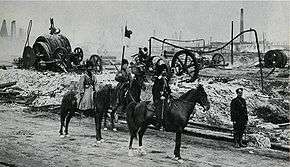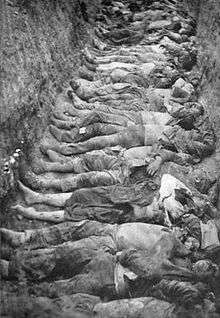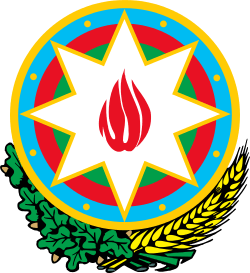Armenian–Tatar massacres of 1905–07
| Armenian–Tatar massacres | ||||||||
|---|---|---|---|---|---|---|---|---|
| Part of Revolution of 1905 | ||||||||
 A Cossack military patrol near the Baku oilfields, ca. 1905. | ||||||||
| ||||||||
| Belligerents | ||||||||
|
Armenian groups | Caucasian Muslim groups[1] |
| ||||||
The Armenian–Tatar massacres (also known as the Armenian-Tartar war and the Armeno-Tartar war and more recently, the Azeri-Armenian war[2]) refers to the bloody inter-ethnic confrontation between Armenians and Azerbaijanis (at the time commonly referred to as "Tatars")[3][4] throughout the Caucasus in 1905–1907.[5][6][7]
The massacres started during the Russian Revolution of 1905, and claimed hundreds of lives. The most violent clashes occurred in 1905 in February in Baku, in May in Nakhchivan, in August in Shusha and in November in Elizavetopol, heavily damaging the cities and the Baku oilfields. Some violence, although of lesser scale, broke out also in Tbilisi.
According to professor Firuz Kazemzadeh, "it is impossible to pin the blame for the massacres on either side. It seems that in some cases (Baku, Elizavetpol) the Azerbaijanis fired the first shots, in other cases (Shusha, Tiflis) the Armenians."[8] The clashes were not confined to the towns, and, according to Swietochowswki, citing Armenian sources 128 Armenian and 158 Azerbaijani villages were destroyed or pillaged,[9] while the overall estimates of lives lost vary widely, ranging from 3,000 to 10,000, with Azerbaijanis suffering higher losses,[10] which stemmed from Azeri mobs being organized poorly and Dashnaks on the Armenian side being more effective.[11]
In Baku
_victim_in_Baku.jpg)
According to van der Leeuw clashes started in early February 1905 over the killing of a Tatar schoolboy and shopkeeper by Armenians.[12] 126 Tatars (Azeris) and 218 Armenians were killed during four days of fighting in Baku.[12] Other sources such as Dasnabedian, or Walker claim that Azeris had started the conflict which gave Armenians a reason to give a strong response, Tatars had killed many unarmed Armenians in Baku, in February 1905. Walker also said that, "Tatars were free to massacre with impunity".[12]
According to Baku statistic bureau and Tartar-Russian-Armenian committee of Assistance to Victims, 205 Armenians were killed, which included 7 women, 20 children, and 13 elderly, along with 121 wounded; and 111 Tartars were killed, consisting of 2 women and no children or elderly, and as well as 128 injured.[13] These statistics disprove van der Leeuw's claims that clashes began over a killed Tatar schoolboy.
13 September 1905 — in the Paris edition of the New York Herald:
| “ | Holy War Waged
St. Petersburg: The districts of Zangezur and Jebrail are swarming with Tartar bands under the leadership of chiefs, and in some cases accompanied by Tartar police officials. Green banners are carried and a ‘Holy War’ is being proclaimed. All Armenians, without distinction of sex or age are being massacred. Many thousand Tartar horsemen have crossed the Perso-Russian frontier and joined the insurgents. Horrible scenes attended the destruction of the village of Minkind. Three hundred Armenians were massacred and mutilated. The children were thrown to the dogs and the few survivors were forced to embrace Islamism. |
” |
These killings would be the first of three massacres of Baku Armenians in the 20th century (including the September Days in 1918 and the Baku pogrom in 1990) which resulted complete emptying of the city from its Armenian population.
In Nakhichevan

After the Baku clashes, Muslim communities in the Nakhichevan district began smuggling consignments of weapons from Persia. By April, murders of Armenians in the district began to assume alarming proportions and they applied to the Russian authorities for protection. However, Villari describes the district's governor as "bitterly anti-Armenian", and the vice-governor in Yerevan as an "Armenophobe".[14]
On 25 May, acting on a prearranged plan, bands of armed Tartars attacked the market area in the district capital, the town of Nakhichevan, looting and burning Armenian businesses and killing any Armenians they could find. About 50 Armenians were murdered and some of the shopkeepers were burnt alive in their shops. The same day, Tartar villagers from the countryside began attacking their Armenian neighbours. Villari cites official reports mentioning that "out of a total of 52 villages with Armenian or mixed Armenian-Tartar populations, 47 were attacked, and of that 47, 19 were completely destroyed and abandoned by their inhabitants. The total number of dead, including those in Nachichevan town, was 239. Later, in a revenge attack, Armenians attacked a Tartar village, killing 36 people".[15]
In Shusha
According to Thomas de Waal in Shusha, "the number of killed and wounded amounted to about 300, of whom about two thirds were Tartars, for the Armenians were better shots and also enjoyed the advantage of position."[16]
Gallery
-

An Armenian house in Tumbul, Nakhichevan plundered by Tatars during the clashes.[1]
-

The village of Djagry in Nakhichevan district: "the house of a rich Armenian burnt by Tartars".[2]
-

An Armenian church in Gyaz village in Nakhichevan district "plundered and desecrated by Tartars".[1]
-

A monument in Berdadzor, Nagorno-Karabakh Republic, to Armenian victims of the 1905–1907 Armenian-Tatar Massacres.
- ^ a b Villari. Fire and Sword, p. 290
- ^ Villari, Luigi. Fire and Sword in the Caucasus. London: T. F. Unwin, 1906 ISBN 0-7007-1624-6 p. 285
See also
References
Notes
- ↑ BUTCHERY IN THE CAUCASUS.; A State of Civil War -- 30,000 Combatants of Various Races New York Times
- ↑ Nicholas W. Miller. Nagorno-Karabakh: A War without Peace. Kristen Eichensehr (ed.), W. Michael Reisman (ed.) Stopping Wars and Making Peace: Studies in International Intervention. Martinus Nijhoff Publishers, 2009
- ↑ Suha Bolukbasi. Nation-building in Azerbaijan. Willem van Schendel (ed.), Erik Jan Zürcher (ed.). Identity politics in Central Asia and the Muslim world. I.B.Tauris, 2001. "Until the 1905—6 Armeno-Tatar (the Azeris were called Tatars by Russia) war, localism was the main tenet of cultural identity among Azeri intellectuals."
- ↑ Joseph Russell Rudolph. Hot spot: North America and Europe. ABC-CLIO, 2008. "To these larger moments can be added dozens of lesser ones, such as the 1905-06 Armenian-Tartar wars that gave Azeris and Armenians an opportunity to kill one another in the areas of Armenia and Azerbaijan that were then controlled by Russia..."
- ↑ Britannica Online Encyclopedia. Azerbaijan. History.
- ↑ Brockhaus and Efron Encyclopedic Dictionary. Turks
- ↑ Willem van Schendel, Erik Jan Zürcher. Identity Politics in Central Asia and the Muslim World: Nationalism, Ethnicity and Labour in the Twentieth Century. I.B.Tauris, 2001. ISBN 1-86064-261-6, ISBN 978-1-86064-261-6, p. 43
- ↑ Firuz Kazemzadeh. Struggle For Transcaucasia (1917—1921), New York Philosophical Library, 1951
- ↑ Cornell, Svante. Small Nations and Great Powers: A Study of Ethnopolitical Conflict in the Caucasus, p. 69.
- ↑ Tadeusz Swietochowski. Russia and Azerbaijan: A Borderland in Transition. Columbia University Press, 1995. ISBN 0-231-07068-3, ISBN 978-0-231-07068-3
- ↑ Cornell, Svante. Small Nations and Great Powers: A Study of Ethnopolitical Conflict in the Caucasus, p. 56.
- 1 2 3 Svante E. Cornell. Small nations and great powers. page 55
- ↑ Saint-Peterburg Vedomosti, 25 May 1905
- ↑ Villari, Luigi. Fire and Sword in the Caucasus. London: T. F. Unwin, 1906 ISBN 0-7007-1624-6 p. 270.
- ↑ Villari, Luigi. Fire and Sword in the Caucasus. London: T. F. Unwin, 1906 ISBN 0-7007-1624-6 p. 270-274.
- ↑ de Waal, Thomas (2003). Black Garden: Armenia and Azerbaijan Through Peace and War. New York: New York University Press. p. 190. ISBN 978-0-8147-1945-9.
Bibliography
- Luigi Villari (1906), Fire and Sword in the Caucasus , London, T. F. Unwin, ISBN 0-7007-1624-6
- Thomas De Waal (2004), Black Garden: Armenia and Azerbaijan Through Peace and War, NYU Press, ISBN 978-0-8147-1945-9
